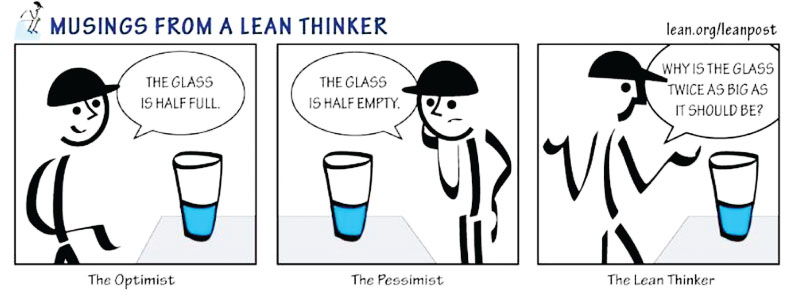Wednesday Jan 07, 2026
Wednesday Jan 07, 2026
Monday, 21 February 2022 01:28 - - {{hitsCtrl.values.hits}}

 What is lean?
What is lean?
Lean management is less about providing the right answers than asking the right questions and exploring them by engaging everyone in experiments to learn through doing. And also, it is all about people and the way they use technology to eliminate waste. In the long run the only sustainable source of competitive advantage is your organisation’s ability to learn faster than your competition. So, throughout your lean journey continuous development of employees and suppliers are vital for sustainability of your lean initiatives.
Lean is an integrated set of principles, tools and techniques designed to address the root causes of operational underperformance. And also, it is a systematic approach to eliminate the sources of waste from entire value streams in order to close the gap between actual performance and the requirements of customers and shareholders with the objectives of optimising quality, cost and delivery while improving safety.
What is waste?
It means any activity which absorbs resources but creates no value. The value is decided by the ultimate customer not by the manufacturer. The value means what the customer is willing to pay and what is important to the customer. The waste we see is the tip of the iceberg and typically management is aware of less than 5% of business waste. The ability to see waste is the fundamental of lean and to see waste we need to calibrate the eyes and minds of our employees through training and development.
Identifying and systematically eliminating waste and reducing necessary non value adding (Incidental) activities, doubling the output with half the resources in half the time, same output with less human effort, less time, less inventory and less space are some of the most popular and better-known definitions of lean.
Traditional thinking vs Lean thinking
Lean is a new paradigm and lean practitioners always live in an investigating mind set. Lean practitioners always challenge the status quo and promote tough standards. When there is a problem, lean practitioners always ask why and what has gone wrong, not who has done it. The application of problem-solving tools along with experience and knowledge to solve problems is a key attribute of a lean practitioner. Engaging everybody at every level in every single day to solve problems leads to a lean culture and a very strong daily management system which is the prerequisites for successful lean implementation.
Lean transformation
The lean transformation is the process of an organisation shifting its business model to desired future state by addressing key questions of purpose, process and people. First, we need to understand the purpose, our basic thinking and current state, situational problems and future state which suits to maximise profit, sustainability and growth of the business and then bring the lean matrix to realise the future state.
Implementing lean is not a copy paste exercise and also not a project. The project has a start and an end but in lean there is no end. It is a never-ending journey. True lean strength comes overtime and depth of experience. The success is driven by the culture of the organisation and the culture is driven by the leadership behaviour at all levels. Understanding our value driven purpose and what situational problems we are going to solve is the starting point of a lean transformation. How to improve people and processes will be our strategy and management system and leadership behaviour will decide the continuations sustainability.
In the process of lean implementation, the senior leaders provide vision (the purpose) and narrow focus. The middle managers create stability and drive implementation and frontline employees continuously improve their jobs and processes by challenging the standardised work which they are following in daily management.
(The writer is Lean Certified from the University of Michigan and the CEO of the Institute of Lean Management.)